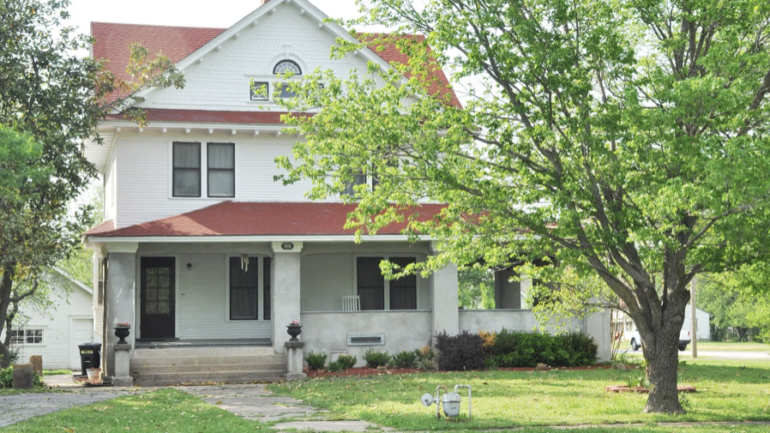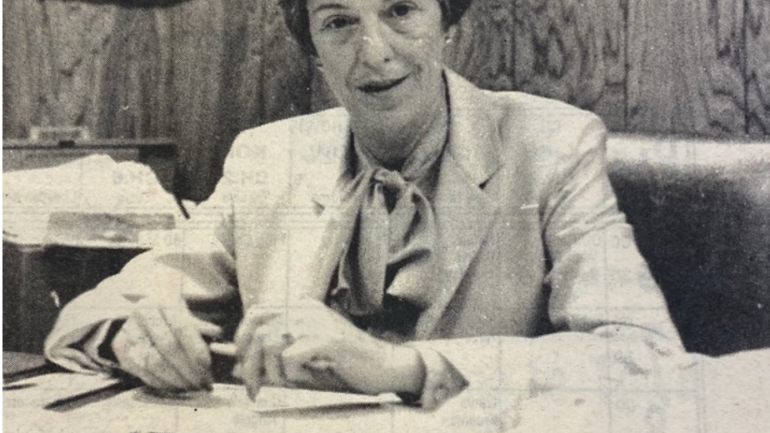Telling the History of Claremore…one story at a time
This article was published in the Claremore Progress, Centennial Edition,
June 17, 1993 byy Pat Reeder.
Before the turn of the century, Philip and Elizabeth Jones Land came to Indian Territory to build a flour mill. It was 1895. Their eldest daughter, Minnie, and her husband, Henry M. Lane, and their three sons came with them.
The families were joined in 1926 when the Streeter’s son, Eltinge, went to California to claim a Lane girl as his bride. Pauline Elizabeth Lane, the first child of Jess (son of Henry M. and Minnie) and Lora Taylor Lane, and Streeter were married February 13, 1926 in Cosa Mesta, California. The next day they set out for “home.” We honeymooned in a Ford Coups between California and Claremore,” said the laughing Pauline Lane Streeter.
Philip Land of the Land Milling Company lived in several states. He actually built five mills, Mrs. Streeter said, pulling a bill of lading from the Neodesha, Kansas, mill from a file. There were mills in Missouri, Oklahoma and Kansas. He would build a mill, then move on, leaving behind a son to operate the business.
The Claremore mill was at what is now Lynn Riggs and 8th, their home was directly across the street. Minnie Land and her husband, Henry M. Lane, came here with the mill, but added a small dairy to the ranch where they lived. In an old issue of the Claremore Progress when W. C. Kates was editor he wrote that he remembered Henry Lane well…and he was quite sure “Mr. Lane will never forget us.” “The first night of our life to spend away from home, as a little lad, was spent in the home of Mr. and Mrs. Lane…that is, part of the night. At a late hour, after all had retired we got to fretting to go back to mother. Mr. Lane sent the boys to the field to saddle up the old gray mare…and we were taken home to our “maw”, Kates wrote.
He also wrote about Harry Kates visiting with his mother and threw a black cat into the Lane’s cistern…drowning the cat and spoiling the water. The Lane’s dairy furnished milk, cream and ice cream for the opening of the Sequoyah Hotel. Jess Lane and Lora Taylor were married December 26, 1905 in Claremore. Pauline Elizabeth, their first child, arrived November 25, 1906 at the family home on the Dave Allton farm. Their son, Henry Munson Lane, was born October 11, 1910 in Claremore.
When Pauline was about six, the family moved to Springfield, Missouri where they were living when her father died in the 1918 flu epidemic. Her father and his brother died within two weeks of each other during the plague which swept the country. About two years later, Lora Lane brought her family back to Claremore to live in a house owned by her grandfather. Pauline finished high school inthe building that is the present Will Rogers Junior High…the school where her own five children graduated.
“My mother was totally unprepared,” she said of her father’s untimely death. “My father was a wonderful person. He never thought about dying young.” Back home in Claremore, her mother did housework for her girlhood friends, “some who were doing quite well.” As soon as she finished high school, Pauline went to Newport Beach, California, where her grandfather Lane was living. She attended Santa Ana Junior College and Orange County Business College…one in the morning, the other in the afternoon.
Back home was an Oklahoma Military Academy cadet she had met at a Halloween party. He was working at a bank. Eltinge Streeter’s family moved to Claremore from Talala and operated a hamburger stand near the courthouse and then opened a dry cleaning business in the Mason Hotel block.
Eltinge Streeter was a first lieutenant in the cadet corp, the first cadet to sleep in Markham Hall, the president of the first graduating class in 1920 and left tackle on the first football team…unbeaten. He attended Chillicothe Business College in Missouri, then went to work at the Bank of Claremore.
In 1925 he went to Laguna Beach to work with his brother-in-law, but he really went to look up Pauline Lane. A few months later the bank “finally gave him an ultimatum, come back or give up his chances for a job with them”. He delivered that ultimatum to Pauline and they were wed and headed back home. During the depression years, he worked at the bank and attended the Oklahoma School of Law, Accountancy and Finance in Tulsa where he graduated in 1933.
Then tragedy struck. His father suffered a heart attack. Again Streeter was working day and night, days at the bank, nights at the cleaners. In 1934 he resigned from the bank to go fulltime with the cleaners and as a tax accountant. The cleaners was later moved to the corner of Will Rogers and Missouri. The late Judge Ava Powell was a partner. Ralph Mason, who worked for Streeter, later purchased the cleaners.
In 1955 when Claremore had a council-manager system, he was one of those who rallied for a water line on Highway 20 serving the Swans, Willard Dunlap and others in the area. It took eight years for the residents to work out a program and arrange financing for the $15,000 waterline.
He served six years as Claremore school district treasurer, served 10 years on the Claremore city council, two terms as mayor, served as Rotary Club president, was on the American Red Cross board and a deacon at First Baptist
Church.
“We had lots of fun,” said Pauline Streeter, who still lives in the home where her family was raised.” While her husband was involved in politics and civic work, she was minding the four daughters and son, Richard, who is in business in Claremore. He operates The Streeter Company in a building where Will Rogers once went to send his telegrams when he was in Claremore.
Pauline wrote her first poem when she was 13. She has written and sold numerous humorous and religious magazine articles. In 1972 she wrote for Home Line, a Christian family magazine, published by Baptist Press. “Once Upon a Kitchen Floor” was inspired after she Chanced to let some water pour and half the dreams that floated past were born of screams that grew too fast.” It is the story of what she found buried behind the washer.
She said she was sick and in bed a lot when the children were little and Eltinge was the backbone of the family. She is proud to have had a story about him published before his death April 11, 1978.
One of her poems was the cover for Jack and Jill magazine in 1963. She used her spare time to write and still does. “I keep a pad by every chair,” she said, capturing the thoughts of the moment. “I have to take it down quick or they are gone and never come back.” It’s from such times as this she has written her Christmas cards and sold them the past two years at the Belvidere and a collection of all-occasion cards sold at the Pink House and Uniquely Sus
The Streeter’s four daughters have moved away. Marcia and Harold Marcum live in Lawrence, Kansas; Lana and Dr. Jim Ferneau live in Columbia, Missouri (he was an OMA cadet); Anita and Bob Simpson (he was a Chelsea boy) live in Garland, Texas; and Joyce Ann and Dr. Dale Roark live in Stillwater.
More than four decades after his forefathers settled in Claremore, Indian Territory, Richard and his wife, Sue, came back to the home of his birth to claim his birthright, a place in Rogers County’s history. Here is where they are raising their family and continuing in the tradition of church and community service. Richard is a Rotarian, served a term on the Claremore city council and is a deacon in First Baptist Church.
History repeats itself.



